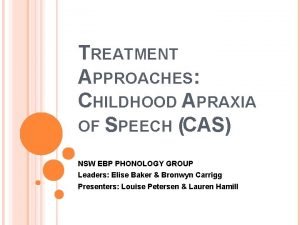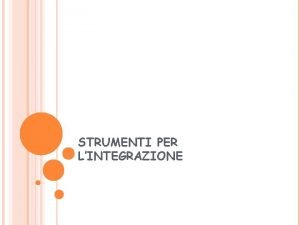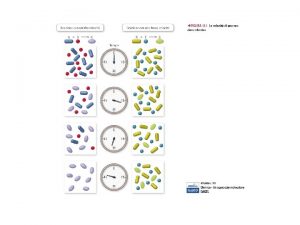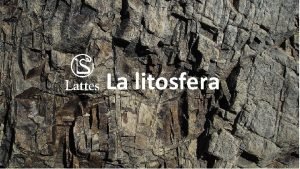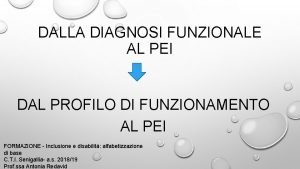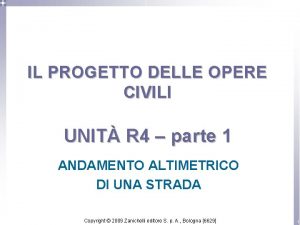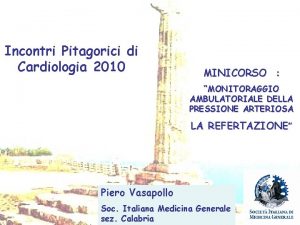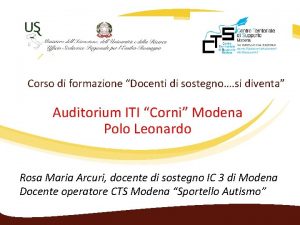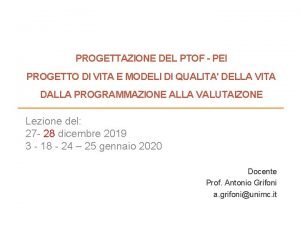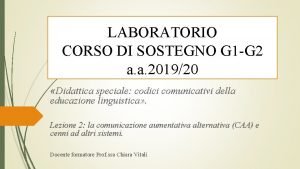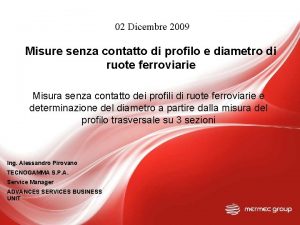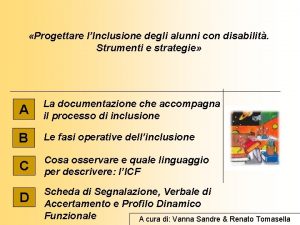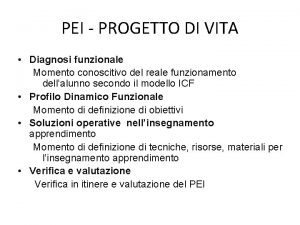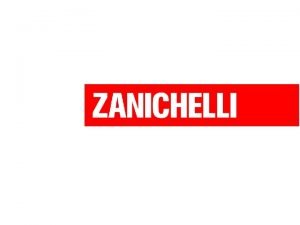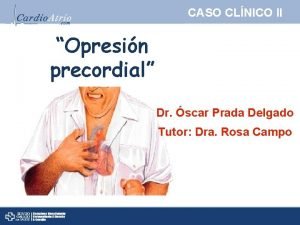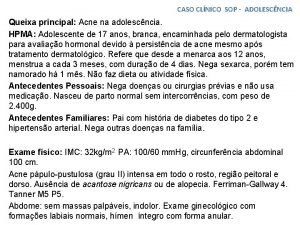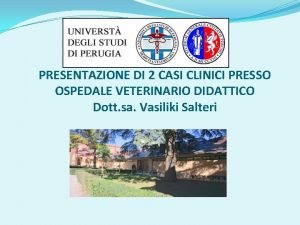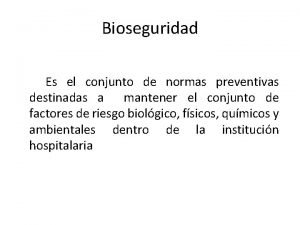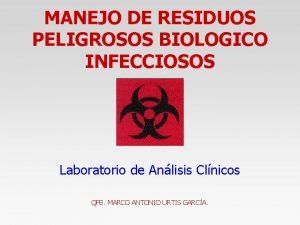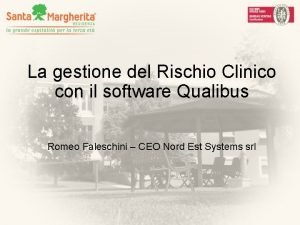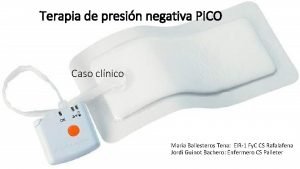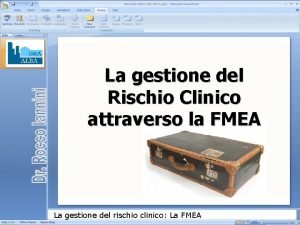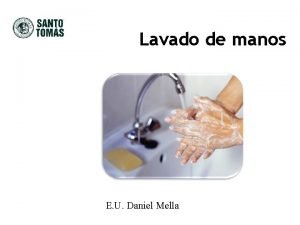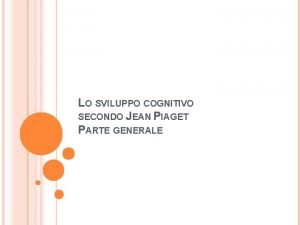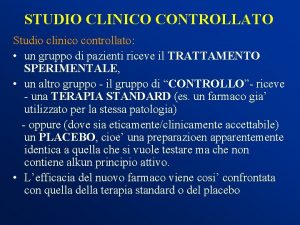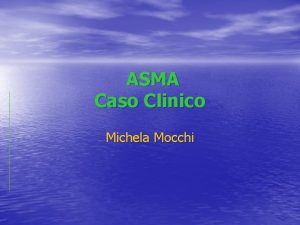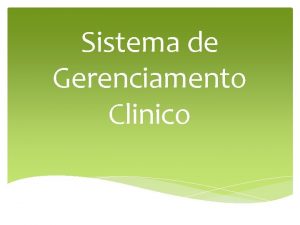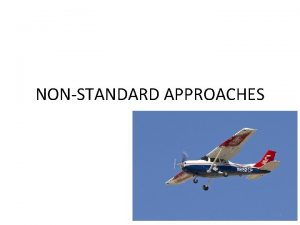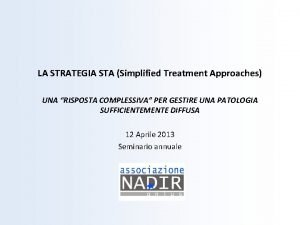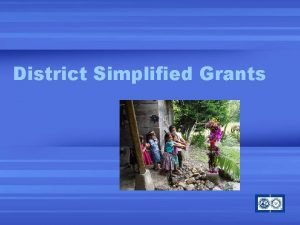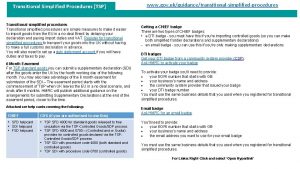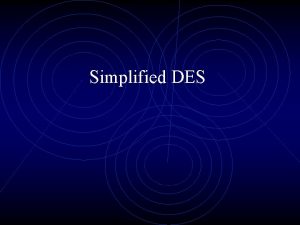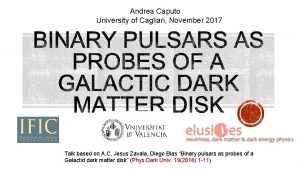SIMPLIFIED TREATMENT APPROACHES PROFILO CLINICO Sergio Lo Caputo

































- Slides: 33

SIMPLIFIED TREATMENT APPROACHES PROFILO CLINICO Sergio Lo Caputo Malattie Infettive Azienda Sanitaria Firenze Roma, 9 maggio 2014 Seminario Nadir 2014 - Iniziativa resa possibile grazie al supporto di Gilead Sciences

Antiretroviral therapy history Durability Effectiveness Sustainability Efficacy Early 80 s Late 80 s Early 90 s Mid 90 s Late 90 s Early 00 s Late 00 s

Available Antiretrovirals 2014 NRTIs NNRTIs Protease Inhibitors New Classes • Abacavir • Efavirenz • Atazanavir • Didanosine • Nevirapine • Darunavir • Emtricitabine • Etravirine • Fos-Amprenavir • Lamivudine • Rilpivirine • Indinavir R 5 Inhibitors • Stavudine • Lopinavir • Maraviroc • Tenofovir • Nelfinavir • Zidovudine • Ritonavir Fixed-dose Combinations AZT/3 TC ABC/3 TC TDF/FTC AZT/3 TC/ABC TDF/FTC/EFV TDF/FTC/RPV TDF/FTC/ELV/COB Fusion Inhibitors • Enfuvirtide Integrase Inhibitors • Saquinavir • Raltegravir • Tipranavir • Elvitegravir • Dolutegravir (2014 www. emea. europa. eu

Proportion of ART classes in first line regimens according to calendar period of starting (NRTIs not considered) 100% 90% 88, 5% 80% 70% 62, 3% 60% 53, 0% 46, 7% 50% 55, 3% 52, 3% 47, 3% 55, 6% PI NNRTI 36, 5% 40% 37, 3% 34, 8% RAL 30% 20% 10% Other 11, 4% 8, 2% 0, 1% 0, 3% 0, 7% 4, 1% 1997 -1999 n=2653 2000 -2002 n=1028 2003 -2005 n=721 2006 -2008 n=707 2009 -2010 n=972 0% 2011 -2013 n=2321 for 2013, 10 months

Proportion of patients with a HIV-RNA<=80 copies/m. L at 12 months from starting their first ART by calendar year of initiation 100% 90% 80% 70% 60% 50% 40% 30% 20% 10% 0% 1997 1998 1999 2000 2001 2002 2003 2004 2005 2006 2007 2008 2009 2010 2011 2012

Il limite delle c. ART attualmente disponibili consiste nell’impossibilità di ottenere l’eradicazione dell’infezione: trattamento deve quindi essere continuato a tempo indefinito e nel corso degli anni è possibile/probabile che insorgano sia problemi di aderenza, sia di tossicità; inoltre, è possibile/probabile che si renda necessario introdurre terapie concomitanti per co-morbilità (con conseguente maggior rischio di interazioni farmacologiche) e che si renda necessario modificare la c. ART per prevenire danni d’organo o anche solo per evitare che i farmaci antiretrovirali aggiungano danno alle inevitabili conseguenze dell’invecchiamento.

Cosa spinge il medico a semplificare una terapia antiretrovirale ? Quali sono le richieste e le necessità del paziente che assume una terapia per tutta la vita ?

Reasons to Switch Antiretrovirals in Patients on a Suppressive Regimen Simplification/convenience Reduce pill burden, dosing frequency, or avoid other specific dosing requirements Tolerability/toxicity Improve short-term tolerability, reduce risk of long-term complications Drug-drug interactions Costs

Principali cause di switch in corso di soppressione virologica Documentata tossicità; - Presenza di effetti collaterali; - Prevenzione di tossicità a lungo termine (pre-emptive switch); - Terapia in atto che possa aggravare comorbosità presenti; - Interazioni con altri farmaci; - Necessità di cura di altre infezioni (TB, HBV, HCV, ecc. ); - Necessità di migliorare l’aderenza alla terapia del paziente; - Pianificazione di gravidanza; - Richiesta del paziente; - Regime in atto non più raccomandato

Reason for change drug during VL <50 copies/ml % S. Lo Caputo et al IWOOD 2013

Ottimizzazione Il termine ottimizzazione della c. ART è utilizzato per indicare strategie finalizzate al miglior risultato possibile, attraverso switch terapeutici anche differenti fra loro e con scopi e razionali diversi, ma sempre in condizioni di soppressione virologica (HIV-RNA < 50 copie/m. L). Ottimizzazione della c. ART non significa necessariamente riduzione del numero di compresse o dosi. Sono immaginabili tre principali modalità di ottimizzazione: • Riduzione del numero di farmaci antiretrovirali; • Riduzione del numero di dosi/somministrazioni e di compresse giornaliere, ma sempre ricorrendo ad uno schema di triplice terapia

Ottimizzazione - Monoterapia

Randomised Controlled Trial of a PI Monotherapy Switch Strategy for Long-term HIV Management (The PIVOT Trial) P-550 LB The Protease Inhibitor Monotherapy Versus Ongoing Triple Therapy (PIVOT) Trial was a 5 -year prospective, randomised, controlled, open-label strategy trial performed in 43 centres in the United Kingdom. Primary outcome: loss of future drug options, defined as new intermediate/high level resistance to ≥ 1 drug to which the patient’s virus was considered to be sensitive at trial entry Secondary outcomes: included serious disease complications (AIDS, serious non-AIDS, allcause death), total grade 3/4 adverse events and neurocognitive function change

Results We randomised 587 patients who were followed for a median (maximum) of 44 (59) months; 2. 7% withdrew or were lost-to follow up (Fig 2). In PIm, 80% selected DRV/r, 14% LPV/r, 7% other PI/r at randomisation. VL rebound was much more common in Pim, but all rebounds on PIm re-suppressed either spontaneously or with NRTI reintroduction. Sequences were obtained in 83% of confirmed VL rebounds. Few new resistance mutations were seen in either arm. PIm was non-inferior on the primary outcome of loss of future drug options and had fewer Grade 3/4 adverse events.

In Which Setting(s) Can Boosted PI Monotherapy Be Regarded as Safe? In virologically suppressed patients (either on PI- or NNRTI-based regimens) No history of PI failure No previous HIV-related encephalopathy Absence of HBV coinfection (or other conditions in which NRTIs are essential for therapy) Patients able to tolerate low-dose RTV Patients with history of optimal adherence Nadir CD 4+ cell count > 100 cells/mm³[1 -3] or HIV-1 RNA < 105 copies/m. L[4] Low number of patients eligible for PI/r monotherapy 1. Pulido F, et al. Antivir Ther. 2009; 14: 195 -201. 2. Campo R, et al. CROI 2007. Abstract 514. 3. Gutmann C, et al. AIDS. 2010; 24: 2347 -2354. 4. Katlama C, et al. AIDS. 2010; 24: 2365 -2374.

Ottimizzazione (CNA-SIMIT 2013) Duplice terapia

Riduzione del numero di dosi/somministrazioni e di compresse giornaliere

STR Single. Tablet Regimen Atripla (TDF/FTC/EFV) Eviplera (TDF/FTC/RPV) Stribild (TDF/FTC/ELV/COB)

Life. Link Database Complete Non-Adherence to ART Regimens Retrospective analysis of US healthcare claims for commercially insured population (n=4, 588) receiving 2 NRTIs plus NNRTI or PI or INSTI based ART (2009 – 2011) Percentage of Days • Complete non-adherence was relatively similar across regimens 10% Raltegravir n=522 12% Boosted PI n=1, 601 Cohen 19 C, et al. ICAAC 2012; San Francisco, CA. #H-211 8% NNRTI n=657 10% STR n=1, 751 Complete Non-adherence

Life. Link Database Partial and Complete Non-Adherence to ART Regimens Retrospective analysis of US healthcare claims for commercially insured population (n=4, 588) receiving 2 NRTIs plus NNRTI or PI or INSTI based ART (2009 – 2011) Percentage of Days p<0. 0001 21% 20% p<0. 0001 • STR patients had significantly more days with a complete regimen 15% 10% Raltegravir n=522 12% Boosted PI n=1, 601 Cohen 20 C, et al. ICAAC 2012; San Francisco, CA. #H-211 Partial Adherence 8% NNRTI n=657 10% STR n=1, 751 Complete Non-adherence

Life. Link Database Association of Adherence and Hospitalization Rate Adjusted Hospitalization Rate, % Patients Among non-STR cohorts, patients who were completely and partially non-adherent were significantly more likely to be hospitalized vs. those only completely non adherent 25% 20% Complete Non-adherence only OR: 1. 43 p<0. 0001 10. 2% OR: 1. 50 p<0. 0001 16. 0% 14. 6% 15% 10% OR: 1. 54 p<0. 0001 Complete and Partial Non Adherence* 10. 4% 15. 4% 10. 3% 10. 4% 5% 0% N/A Raltegravir n=522 Boosted PI n=1, 601 NNRTI n=657 Hospitalization rate adjusted for differences between groups including complete non-adherence, treatment status at index, age, geographic location, plan and types. * Partial Adherence: Patients with at least 5% of days with either no NRTIs or no 3 rd agents. Cohen 21 C, et al. ICAAC 2012; San Francisco, CA. #H-211 STR n=1, 751

Current and Future STR Options for ARV-Naïve Patients Current ATRIPLA (1550 mg) EVIPLERA (1150 mg) STRIBILD (1350 mg) QUAD 1 ATRIPLA 2 Future DRV/COBI/FTC/TAF (1550 mg) EVG/COBI/FTC/TAF (1050 mg) ABC/3 TC/DLV TAF = tenofovir alafenamide; investigational tenofovir prodrug (GS-7340) 22 EVIPLERA 3 EVG/COBI/FTC/TAF DRV/COBI/FTC/TAF 1. German P, et al. JAIDS 2010; 55: 323– 329 2. Mathias AA, et al. JAIDS; 2007; 46(2): 167 -73 3. Mathias AA, et al. IAC 2010; Vienna. THLBPE 17

STR per quale paziente? I due nuovi STR hanno ampliato di molto la possibilità di usufruire di un intero regime in unica compressa Naive: sia pazienti a bassa carica virale che ad alta viremia Switch: pazienti con buona tollerabilità al TDF/FTC e sensibilità a RPV e ELV Importanza dei dati sulla pregressa storia terapeutica (genotipo storico)

2012

Main differences SPIRAL vs. SWITCHMRK 1&2 Studies SPIRAL SWITCHMRK 1&2 N 273 702 Design Open Double-blind, doub dummy PI/r Any (44% LPV/r) LPV/r Time on VL<50 c/m. L >6 months > 3 months Prior virol failure 38% 33. 5% Median CD 4 cells, BL 516 cells 445 cells Median Time Undetec. VL 73 (39– 106) months unknown Improvement in LDL-Chol Yes No % with VL < 50 c/m. L RAL 96. 9%, PI/r 95. 1% (48 w) RAL 84. 4%, LPV/r 90. 6% (24 w) Increased RAL failure with prior VF and not being on the 1 st ART NO YES ?

Need to avoid drug-drug interactions ATV/r DRV/r LPV/r EFV ETV NVP RPV MVC RAL atorvastatin ↑ ↑ ↑ 490% ↓ 43% ↓ 37% ↓ ↔ ↔ ↔ rosuvastatin ↑ 213% ↑ 48% ↑ 107% ↔ ↑ ↔ ↔ simvastatin ↑ ↑ ↑ ↓ 68% ↓ ↓ ↔ ↔ ↔ amlodipine ↑ 3 ↑ ↑ 3 ↓ ↓ ↓ ↔ ↔ ↔ ↑or ↓ ↓ ↓ ↑or ↓ ↑ ↑or ↓ ↔ ↔ ↔ diazepam ↑ ↑ ↑ ↓ ↔ ↔ ↔ citalopram ↑ 3 ↑ ↑ 3 ↓ ↓ ↓ ↔ ↔ ↔ mirtazapine ↑ ↑ ↑ ↓ ↓ ↓ ↔ ↔ ↔ D 35% ↓ 32%D 44% ↓ 45%D 34% ↓ 19%E 20% ↑ 10%D 23% ↓E E E ↔ clarithromycin ↑ 3 ↑ ↑ 3 ↓ ↓E ↓ E E ↔ fluconazole ↔ ↔ E 86% E 100% E ↔ ↔ itraconazole ↑E ↑E ↑E ↓ ↓E ↓ 61% E E ↔ rifabutin ↑ ↑E 50% ↑ ↓ D 37% ↑ 17% D * ↔ rifampicin D 72% D D D 26% D D 58% D 80% D D 40% telaprevir ↓ 20%E 17% ↓ 35%D 40% ↓ 54% ↓ 26%D 7% ↓ 16% ↓? ↓ 5%E E E 31% antacids D ↔ ↔ ↔ D PPIs D ↔ ↔ ↔ D ↔ E H 2 blockers D ↔ ↔ ↔ D ↔ E ergot derivatives ↑ ↑ ↑ ↓ E ↔ ↔ ↓ 2, 3 ↓ 16% ↓ 53%3 ↓ 52% ↑ 6% ↓≈50% ↓ 16% ↔ ↔ sildenafil (erec. dys. ) ↑ ↑ ↑ ↓ ↓ 37% ↓ ↔ ↔ ↔ St John's wort D D D D ↔ warfarin boceprevir methadone Cortesía de Catia Marzolini (EACS guidelines, 2013 update)

Drug–Drug Interactions With Acid. Reducing Medications and Newer ARVs ARV Antacids H 2 -Receptor Antagonists Proton Pump Inhibitors Give antacids at least 2 hrs before or at least 4 hrs after RPV Give H 2 -receptor antagonists at least 12 hrs before or at least 4 hrs after RPV Contraindicated EVG/COBI TDF/FTC[1] Separate EVG/COBI/ FTC/TDF and antacid administration by > 2 hrs No clinically relevant interactions DTG[2] DTG should be given 2 hrs before or 6 hrs after taking medications containing polyvalent cations RPV[1] 1. DHHS Adult Guidelines. February 2013. 2. Dolutegravir [package insert]. No clinically relevant interactions

Semplificazione e farmaci generici


Semplificazione: per molti ma non per tutti

Punti chiave nella scelta di un regime di semplificazione da parte del medico Conoscenza della storia terapeutica Importanza dei test di resistenze (genotipo storico) Prevenire e/o trattare eventuali Co-morbilità Interazioni farmacologiche Comprendere l’evoluzione della c. ART Comprendere/conoscere il paziente Garantire eventuali altre opzioni terapeutiche Garantire la soppressione virologica

Simplified Treatment Approaches Miglioramento della qualità della vita del paziente Successo più duraturo nel tempo Ampliamento delle scelte terapeutiche in base alle caratteristiche del paziente

Seminario Nadir 2014 - Iniziativa resa possibile grazie al supporto di Gilead Sciences
 Cas treatment approaches
Cas treatment approaches Decreto 96 2019 sintesi mappa
Decreto 96 2019 sintesi mappa Profilo dinamico funzionale
Profilo dinamico funzionale Cinetica di ordine zero farmacologia
Cinetica di ordine zero farmacologia Micerino tra due dee
Micerino tra due dee Il profilo del suolo
Il profilo del suolo Punti di forza e debolezza alunni esempi
Punti di forza e debolezza alunni esempi Profilo dinamico funzionale esempio compilato
Profilo dinamico funzionale esempio compilato Il profilo del suolo
Il profilo del suolo Livellette di progetto
Livellette di progetto Extreme dipper significato
Extreme dipper significato Profilo dinamico funzionale
Profilo dinamico funzionale Pei progetto di vita
Pei progetto di vita Profilo glottomatetico funzionale
Profilo glottomatetico funzionale Esempio verifica pei
Esempio verifica pei Profilo dello studente
Profilo dello studente Profilo continuo del duce
Profilo continuo del duce Profilo ruota ferroviaria
Profilo ruota ferroviaria Profilo dinamico funzionale
Profilo dinamico funzionale Profilo dinamico funzionale
Profilo dinamico funzionale Il profilo del suolo
Il profilo del suolo Caso clinico de neumonia
Caso clinico de neumonia Caso clínico sop
Caso clínico sop Caso clinico veterinario
Caso clinico veterinario Lavado de manos quirúrgico 3 tiempos
Lavado de manos quirúrgico 3 tiempos Area de rpbi en un laboratorio clinico
Area de rpbi en un laboratorio clinico Activation synthesis theory
Activation synthesis theory Root cause analysis slide
Root cause analysis slide Caso clinico
Caso clinico Fasi del rischio clinico
Fasi del rischio clinico Estudios transversales
Estudios transversales Tiempo lavado de manos clinico
Tiempo lavado de manos clinico L'intelligenza secondo piaget
L'intelligenza secondo piaget Neutropenia febril
Neutropenia febril
